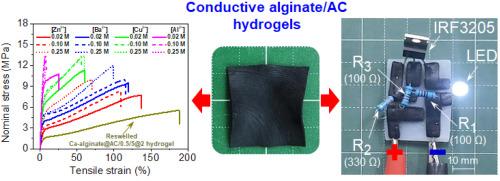Evaluating the effect of strong binding affinity ions on mechanical properties, electrical conductivity, and weldability of conductive alginate-based hydrogels
IF 4.5
2区 化学
Q2 POLYMER SCIENCE
引用次数: 0
Abstract
Next-generation applications, such as actuators, sensors, soft robotics, and electronic devices, require flexible and wearable materials with robust mechanical properties, exceptional electrical conductivity, and complex designability. Additionally, using sustainable substances as alternatives to conventional ones is crucial for environmental preservation and minimizing fossil fuel usage. In this study, conductive hydrogels based on naturally derived materials, including alginate and activated charcoal (AC), have been successfully developed. They are created using an ion diffusion method, followed by drying and rehydration techniques, and an ion exchange process. The effect of strong binding affinity ions, such as Zn2+, Ba2+, Cu2+, and Al3+, on the mechanical performances, electrical conductivity, and weldability of the hydrogels is assessed transparently. The findings indicate that the hydrogel prepared with Ba2+ exhibits remarkable mechanical properties (Young’s modulus: ∼106.83 MPa, tensile strength: ∼10.31 MPa, and work of extension: ∼8.17 MJ·m−3). Meanwhile, Zn2+ imparts favorable electrical conductivity (∼0.537 mS·cm−1) and excellent welding efficiency (adhesive strength: ∼1.14 MPa) to the gel. Monovalent ions, such as Li+, can be incorporated into the hydrogels to enhance conductivity (∼2.388 mS·cm−1), yet their presence has a negligible effect on the gels’ mechanical properties. Furthermore, the gels are successfully utilized to fabricate flexible and wearable electrical components, such as electrical circuits. Considering these capabilities, the developed conductive hydrogels hold potential for applications in electronics and load-bearing systems.

评价强结合亲和离子对导电海藻酸盐基水凝胶力学性能、电导率和可焊性的影响
下一代应用,如执行器、传感器、软机器人和电子设备,需要柔性和可穿戴材料,具有强大的机械性能、卓越的导电性和复杂的可设计性。此外,使用可持续物质作为传统物质的替代品对于环境保护和尽量减少化石燃料的使用至关重要。在这项研究中,基于天然衍生材料的导电水凝胶,包括海藻酸盐和活性炭(AC),已经成功开发。它们是通过离子扩散法,然后是干燥和再水化技术,以及离子交换过程产生的。透明地评估了Zn2+、Ba2+、Cu2+和Al3+等强结合亲和离子对水凝胶力学性能、电导率和可焊性的影响。结果表明,用Ba2+制备的水凝胶具有显著的力学性能(杨氏模量:~ 106.83 MPa,抗拉强度:~ 10.31 MPa,拉伸功:~ 8.17 MJ·m−3)。同时,Zn2+赋予凝胶良好的导电性(~ 0.537 mS·cm−1)和优异的焊接效率(粘结强度:~ 1.14 MPa)。一价离子,如Li+,可以加入到水凝胶中以提高电导率(~ 2.388 mS·cm−1),但它们的存在对凝胶的机械性能的影响可以忽略不计。此外,该凝胶被成功地用于制造柔性和可穿戴的电子元件,例如电路。考虑到这些性能,开发的导电水凝胶在电子和承重系统中具有应用潜力。
本文章由计算机程序翻译,如有差异,请以英文原文为准。
求助全文
约1分钟内获得全文
求助全文
来源期刊

Polymer
化学-高分子科学
CiteScore
7.90
自引率
8.70%
发文量
959
审稿时长
32 days
期刊介绍:
Polymer is an interdisciplinary journal dedicated to publishing innovative and significant advances in Polymer Physics, Chemistry and Technology. We welcome submissions on polymer hybrids, nanocomposites, characterisation and self-assembly. Polymer also publishes work on the technological application of polymers in energy and optoelectronics.
The main scope is covered but not limited to the following core areas:
Polymer Materials
Nanocomposites and hybrid nanomaterials
Polymer blends, films, fibres, networks and porous materials
Physical Characterization
Characterisation, modelling and simulation* of molecular and materials properties in bulk, solution, and thin films
Polymer Engineering
Advanced multiscale processing methods
Polymer Synthesis, Modification and Self-assembly
Including designer polymer architectures, mechanisms and kinetics, and supramolecular polymerization
Technological Applications
Polymers for energy generation and storage
Polymer membranes for separation technology
Polymers for opto- and microelectronics.
 求助内容:
求助内容: 应助结果提醒方式:
应助结果提醒方式:


